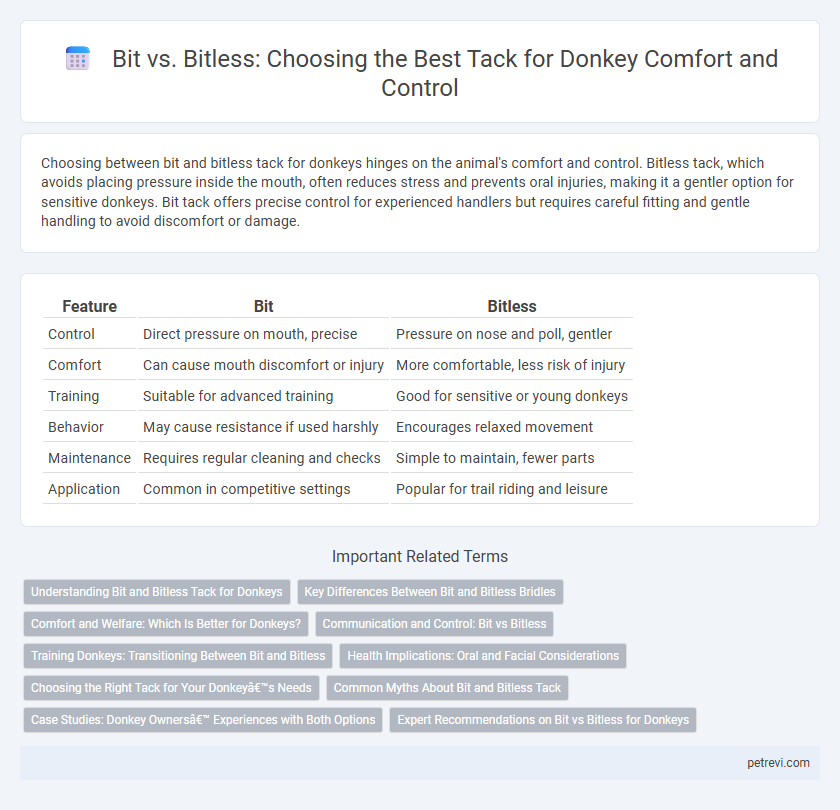Choosing between bit and bitless tack for donkeys hinges on the animal's comfort and control. Bitless tack, which avoids placing pressure inside the mouth, often reduces stress and prevents oral injuries, making it a gentler option for sensitive donkeys. Bit tack offers precise control for experienced handlers but requires careful fitting and gentle handling to avoid discomfort or damage.
Table of Comparison
| Feature | Bit | Bitless |
|---|---|---|
| Control | Direct pressure on mouth, precise | Pressure on nose and poll, gentler |
| Comfort | Can cause mouth discomfort or injury | More comfortable, less risk of injury |
| Training | Suitable for advanced training | Good for sensitive or young donkeys |
| Behavior | May cause resistance if used harshly | Encourages relaxed movement |
| Maintenance | Requires regular cleaning and checks | Simple to maintain, fewer parts |
| Application | Common in competitive settings | Popular for trail riding and leisure |
Understanding Bit and Bitless Tack for Donkeys
Bit tack for donkeys includes metal pieces placed in the mouth to control direction and speed, often used in riding and driving. Bitless tack uses pressure points on the head, such as nosebands or hackamores, avoiding mouth discomfort while maintaining control. Choosing between bit and bitless gear depends on the donkey's temperament, sensitivity, and specific training needs to ensure comfort and effective communication.
Key Differences Between Bit and Bitless Bridles
Bit bridles for donkeys apply pressure directly to the animal's mouth, facilitating precise control but potentially causing discomfort if misused. Bitless bridles distribute pressure across the donkey's nose and poll, promoting gentler communication and reducing risks of oral injuries. Choosing between bit and bitless tack depends on the donkey's temperament, training level, and rider's control requirements.
Comfort and Welfare: Which Is Better for Donkeys?
Bitless tack enhances donkey comfort by eliminating pressure on the sensitive bars and tongue, reducing stress and risk of mouth injuries. Studies indicate bitless bridles promote natural jaw movement and better breathing, supporting overall welfare in donkeys. Choosing bitless options aligns with humane handling practices and improves long-term health outcomes for donkeys in work or leisure settings.
Communication and Control: Bit vs Bitless
Bit tack for donkeys provides direct communication through pressure on the mouth, allowing precise control, especially in training and guiding situations. Bitless tack works by applying pressure on the donkey's head and poll, promoting a gentler approach that reduces mouth discomfort and enhances comfort during longer rides. Choosing between bit and bitless tack depends on the desired control level and the donkey's sensitivity, impacting communication effectiveness and rider experience.
Training Donkeys: Transitioning Between Bit and Bitless
Training donkeys requires carefully transitioning between bit and bitless tack to ensure comfort and responsiveness. Using bitless bridles can reduce mouth sensitivity and promote natural communication, while bits offer precise control during advanced training stages. Gradual introduction and monitoring of the donkey's behavior are essential to achieve effective guidance without causing stress or discomfort.
Health Implications: Oral and Facial Considerations
Bitless donkey tack reduces the risk of oral injuries such as mouth ulcers, tongue lacerations, and dental damage commonly associated with bits. Using a bit can cause chronic pain, inflammation, and behavioral issues due to the pressure on sensitive facial nerves and soft tissues. Bitless tack promotes better respiratory function and reduces stress on the donkey's jaw and poll, enhancing overall comfort and health.
Choosing the Right Tack for Your Donkey’s Needs
Selecting the right donkey tack involves understanding the differences between bit and bitless options to ensure comfort and control. Bitless tack, such as hackamores or side-pulls, reduces pressure on sensitive areas of the donkey's mouth, ideal for donkeys with dental issues or behavioral sensitivities. Bit tack provides direct communication through the reins, offering precise control for trained donkeys accustomed to mild pressure on their mouths.
Common Myths About Bit and Bitless Tack
Common myths about bit and bitless tack for donkeys often claim that bits cause pain or that bitless options lack control, but both can be effective when properly fitted and used with skill. Donkeys' sensitive mouths require careful selection of bit type or well-designed bitless bridles to ensure comfort and communication. Understanding these misconceptions helps improve donkey welfare and training outcomes by emphasizing correct tack choice over simplistic judgments.
Case Studies: Donkey Owners’ Experiences with Both Options
Case studies of donkey owners reveal varied experiences with bit and bitless tack, highlighting both the comfort and behavior impacts on donkeys. Many owners report that bitless options reduce mouth injuries and stress signs, improving overall performance and compliance during rides. Conversely, bit users often appreciate the precise control offered but acknowledge potential discomfort and behavioral resistance linked to bit use.
Expert Recommendations on Bit vs Bitless for Donkeys
Experts recommend bitless tack for donkeys to prevent mouth injuries and increase comfort, as donkey oral anatomy is more sensitive than horses. Bitless bridles allow for gentler communication and reduce behavioral issues linked to bit discomfort. Veterinarians and equine specialists emphasize assessing individual donkey temperament and training when choosing between bit and bitless options.
Bit vs Bitless for Donkey Tack Infographic

 petrevi.com
petrevi.com